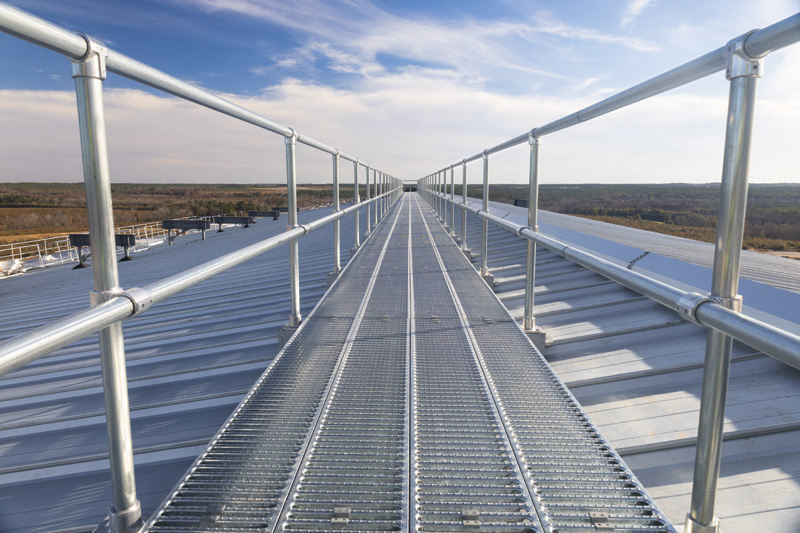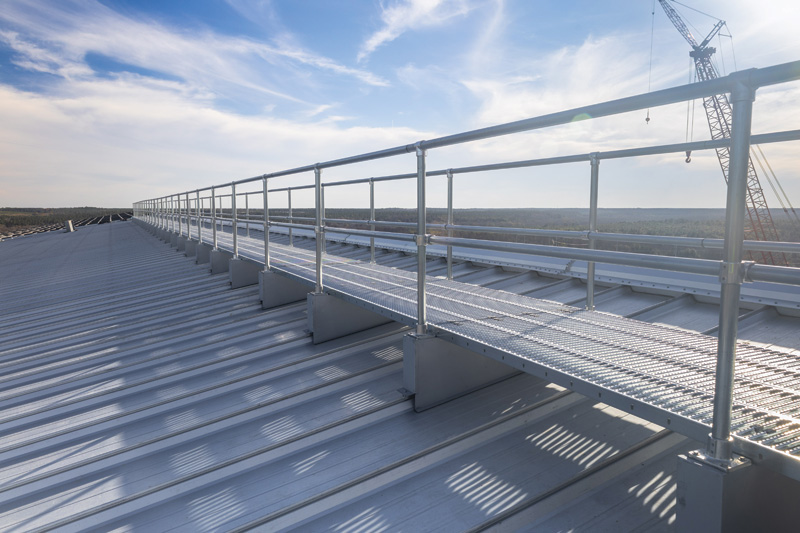Successful and safe rooftop walkway installation
by Christopher Brinckerhoff | 31 January 2025 6:00 am
 [1]
[1]A successful rooftop walkway installation involves several factors. There are many variables to consider, including the type of roof system, weather conditions, safety, Occupational Safety and Health Administration (OSHA) requirements, etc. How are these systems designed and what are their benefits? What are the most common materials used? How are they effectively installed on a roof? These are just some of the many questions to ask before beginning an installation.
Working on rooftops always presents potential hazards, including slips, trips, and falls. Rooftop walkway systems are designed to mitigate these risks by providing a stable and clearly defined path for workers. This is especially crucial in industries where regular rooftop access is necessary, such as HVAC maintenance, solar panel installation and maintenance, and building inspections.
A rooftop walkway system simultaneously shields from foot traffic damage and protects workers or employees from the hazards associated with accessing the rooftop. A complete system starts with the walkway planks or grating, which should include a non-slip surface. These walkway sections will need to be attached to proper supports fastened to the roof, thus distributing the load. Often there are other safety features integrated with or connected to the walkway, including guardrails, toe boards, and swing gates. OSHA-compliant access points to the walkway are important. These include ladders, stairs, and hatches that allow workers to safely reach the rooftop and transition between different levels. Properly designed access points are essential for maintaining a continuous safe path.
When are certain safety features—such as a handrail—required? OSHA requires railings if the roof is accessed within 3.05 m (10 ft) of the roof edge. Railings are also a good idea if working on a higher-pitched roof system (2:12 to 6:12 roof pitches). Researching local building codes will be needed to determine if railings are required for the project. Whether railings are being supplied with the rooftop walkway system or by another supplier, make sure the installation will meet or exceed the OSHA 91 kg (200 lb) lateral load standard, and that test data can be provided for building inspectors to approve.
 [2]
[2]The components making up the system can be made from a variety of materials. These materials may include galvanized steel, Galvalume steel, aluminum, and stainless steel. Galvanized steel construction is the most common material used for walkway grating, and, typically, it will be 18 gauge or heavier and will provide many years of resistance to corrosion and rust.
Upon installation there are also certain factors to consider. Metal roofs can either be standing seam or mechanically fastened. In either case, installers will want to avoid damaging the roof panels. When attaching anything to a standing seam roof panel, it is important to choose non-penetrating seam clamps that do not penetrate the roof and prevent voiding any roof warranty. The style of clamp needed will vary based on the manufacturer and the profile of the roof panel.
Another factor to consider is the pitch of the roof. It is often possible to pitch correct the walkway system so that it runs level. Speak with any supplier prior to specifying a walkway to check whether the system can be pitch-corrected and to what degree. Other issues to consider include: What kind of warranty is included with the system, are PE-stamped drawings called for in the job requirements, and have all applicable building codes been considered? A reliable walkway system supplier can help navigate some of these issues.
While there are a number of things to consider before installing a walkway system, the benefits are worth it. The systems enhance the safety of the structure and workers. Also, many safety regulations require protective measures for rooftop work. Efficiency will be increased since workers can move effectively across the rooftop, reducing the time needed to complete tasks.
Rooftop walkway systems are an important investment. By prioritizing worker safety, having the proper components, and installing the walkway properly, these systems not only protect employees but also enhance operational efficiency and ensure compliance with safety regulations. Investing in a reliable rooftop walkway system is a proactive step toward creating a safer environment for workers.
Cody Fox, marketing and sales representative at Design Components Inc.[3]
- [Image]: https://www.metalconstructionnews.com/wp-content/uploads/2025/01/Metalwalk-48-inch-wide-handrail-pitch-corrected-1.jpg
- [Image]: https://www.metalconstructionnews.com/wp-content/uploads/2025/01/Metalwalk-48-inch-wide-handrail-pitch-corrected-2.jpg
- Design Components Inc.: https://www.designcomponents.com/
Source URL: https://www.metalconstructionnews.com/articles/features/rooftop-walkway/